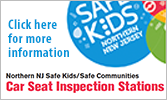When Kids Are At Play, Parents Should Be On Alert
April 26-30, 2011 is Playground Safety Week
Spring is officially here, and a trip to the playground is often a go-to activity that both parents and kids enjoy. While the risks and dangers associated with swimming or riding a bike might seem more obvious, Safe Kids Northern NJ reminds parents to not let their guard down when their kids are playing on the playground. Active supervision and certain safety precautions are necessary to ensure their kids remain healthy and safe.
Morristown, NJ — Spring is officially here, and a trip to the playground is often a go-to activity that both parents and kids enjoy. While the risks and dangers associated with swimming or riding a bike might seem more obvious, Safe Kids Northern NJ reminds parents to not let their guard down when their kids are playing on the playground. Active supervision and certain safety precautions are necessary to ensure their kids remain healthy and safe.
National Playground Safety Week, April 26-30, 2011 will celebrate the 29th anniversary of the U.S. Consumer Product Safety Commission’s Handbook for Public Playground Safety, which provides guidelines for protective surfacing and age-appropriate playground equipment for children.
Each year, approximately 15 children die from injuries involving playground equipment, and more than 200,000 are treated in emergency rooms. Falls account for 80 percent of playground injuries; however, most playground fatalities are caused by strangulation and tend to occur on home playgrounds, not on public property.
“Nothing can take the place of active supervision, but we do need to make sure our kids are playing in safe environments in the first place,” says KJ Feury RN, Morristown Memorial Hospital and Safe Kids Northern NJ Coalition coordinator. “Playgrounds should be separate for children ages 2 to 5 and 5 to 12, and they should have safe surfacing beneath and surrounding all playground equipment.”
Grass and soil are not good playground surfaces. “The ground should be covered 12 inches deep with energy-absorbing materials like shredded rubber, wood chips or sand, extending at least six feet in all directions around the equipment,” says Feury. “It won’t prevent falls, but it can prevent injuries or reduce their severity.”
Even nonfatal injuries from playground falls can be very serious. “About 45% of playground-related injuries are severe, which include fractures, internal injuries, concussions, dislocations, and amputations,” says KJ Feury .
Parents and caregivers need to keep kids in sight and in reach on the playground. “Simply being in the same place as your child isn’t necessarily supervising,” says Feury. “Kids on a playground need your undivided attention.”
Safe Kids Northern NJ also reminds parents and caregivers to:
- Make sure playground equipment is inspected frequently and kept in good repair.
- Remove hood and neck drawstrings from children’s clothing and outerwear and don’t let kids wear helmets, necklaces, purses or scarves on the playground.
- Don’t allow your kids to engage in, or play near, any pushing, shoving or crowding around playground equipment.
- Keep toddlers under age 5 in a separate play area, away from equipment designed for bigger kids.
KJ Feury RN APN, C
karenjean.feury@atlantichealth.org
Phone: 973-971-4327
Fax: 973-290-7350




